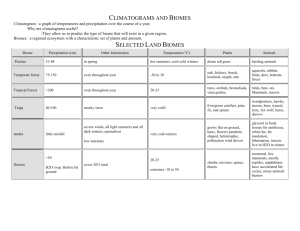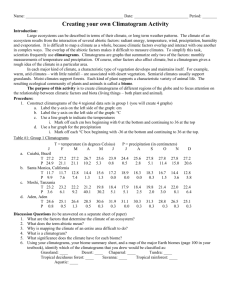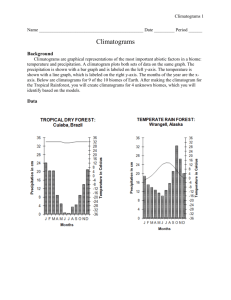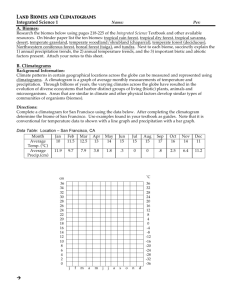Identifying Biomes from Climatograms
advertisement
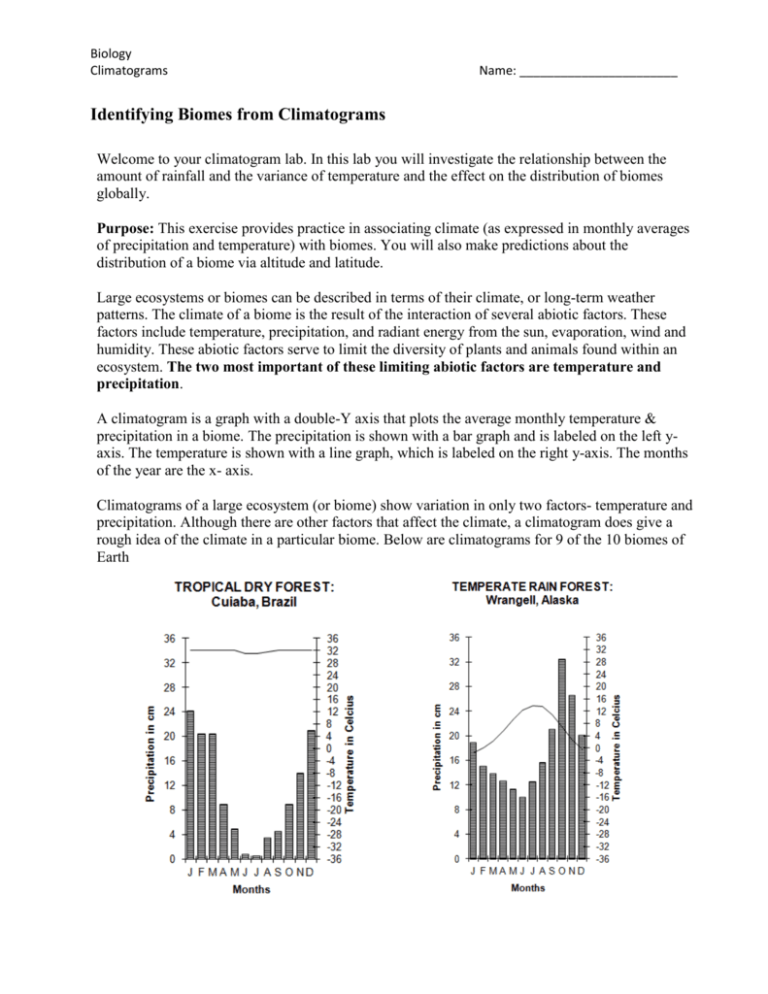
Biology Climatograms Name: _______________________ Identifying Biomes from Climatograms Welcome to your climatogram lab. In this lab you will investigate the relationship between the amount of rainfall and the variance of temperature and the effect on the distribution of biomes globally. Purpose: This exercise provides practice in associating climate (as expressed in monthly averages of precipitation and temperature) with biomes. You will also make predictions about the distribution of a biome via altitude and latitude. Large ecosystems or biomes can be described in terms of their climate, or long-term weather patterns. The climate of a biome is the result of the interaction of several abiotic factors. These factors include temperature, precipitation, and radiant energy from the sun, evaporation, wind and humidity. These abiotic factors serve to limit the diversity of plants and animals found within an ecosystem. The two most important of these limiting abiotic factors are temperature and precipitation. A climatogram is a graph with a double-Y axis that plots the average monthly temperature & precipitation in a biome. The precipitation is shown with a bar graph and is labeled on the left yaxis. The temperature is shown with a line graph, which is labeled on the right y-axis. The months of the year are the x- axis. Climatograms of a large ecosystem (or biome) show variation in only two factors- temperature and precipitation. Although there are other factors that affect the climate, a climatogram does give a rough idea of the climate in a particular biome. Below are climatograms for 9 of the 10 biomes of Earth Biology Climatograms Name: _______________________ Biology Climatograms Name: _______________________ Graph 1: Tropical Rain Forest: Kauai, Hawaii J F M A M J J A S O N D P: 50 45 48 94 72 54 59 55 54 51 64 67 T: 20.0 20.1 20.6 21.3 22.1 23.0 23.2 23.6 23.7 23.3 22.2 20.9 Graph 2: Unknown A J F M A M J J A S O N D P: 8.1 7.6 8.9 8.4 9.2 9.9 11.2 10.2 7.9 7.9 6.4 7.9 T: 1.1 1.7 6.1 12.2 17.8 22.2 25 23.3 20 13.9 7.8 2.2 Graph 3: Unknown B J F M A M J J A S O N D P: 25.8 24.9 31 16.5 25.4 18.8 16.8 11.7 22.1 18.3 21.3 29.2 T: 25.6 25.6 24.4 25 24.4 23.3 23.3 24.4 24.4 25 25.6 25.6 Graph 4: Unknown C J F M A M J J A S O N D P: 1 1.3 1 0.3 0 0 0.3 1.3 0.5 0.5 0.8 1 T: 12.8 15 18.3 21.1 25 29.4 32.8 32.2 28.9 22.2 16.1 13.3 Graph 5: Unknown D J F M A M J J A S O N D P: 1 1.3 1.8 1.5 1.5 1.3 2.3 2.8 2.8 2.8 2.8 1.3 T: -22.2 -22.8 -21.1 -14.4 -0.39 1.7 5 5 1.1 -3.9 -10 -17.2 Biology Climatograms Name: _______________________ Procedure: 1. Use the blank templates below. 2. Make a climatogram for the Tropical Rainforest of Hawaii from the data above. 3. Graph the remaining 4 climatograms and use the models given to predict the type of Biome they represent. 4. Be sure that you label each with its biome name. 5. All temperature readings are measured on the right side of the climatogram. All precipitation measurements are on the left side of the climatogram. 6. Be sure to draw line a graph for temperature and a bar graph for precipitation. Kauai, Hawaii Graph 2 Biology Climatograms Name: _______________________ Graph 3 Graph 4 Graph 5 Biology Climatograms Name: _______________________ Analysis Questions 1. Determine the identities of unknown biomes A-D: Explain your reasoning for each. Graph 2: Graph 3: Graph 4: Graph 5: 2. Western Washington incldes a Temperate Forest biome. Look up a climatogram for western Washington and compare it with the other climatograms you plotted. a. Which climatogram most closely resembles that of a Temperate Forest? b. What similarities are there between the two? c. What differences are there? 3. How would climatograms be used by scientists? (What is their purpose?) 4. How could altitude (increased and decreased) alter a climatogram? 5. Which biome has the greatest average rainfall? ____________________________ Least? ___________________________ Which has the highest average temp? _________________________________ Lowest? _____________________________ Biology Climatograms Name: _______________________ 6. Research each of the biomes for which you plotted a climatograms. Identify the major type of vegetation that identifies the biome. Describe the plant’s adaptations that are critical for its survival and reproduction in that climate. Also, identify one animal symbiotic relationship that can be found in each Biome. Describe the relationship including benefit/harm of each of the individuals in the relationship. Tropical Rain Forest: Major vegetation adaptations Type of Symbiotic relationship description Graph 2 Biome: Major vegetation adaptations Type of Symbiotic relationship description Graph 3 Biome: adaptations Major vegetation Type of Symbiotic relationship description Biology Climatograms Name: _______________________ Graph 4 Biome: Major vegetation adaptations Type of Symbiotic relationship description Graph 5 Biome: Major vegetation adaptations Type of Symbiotic relationship description
